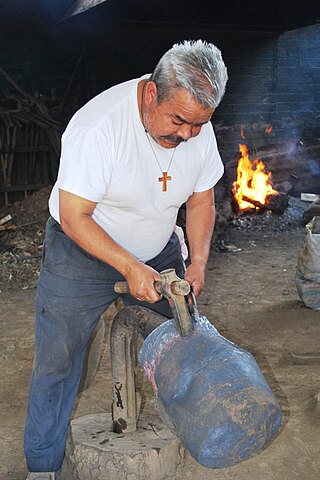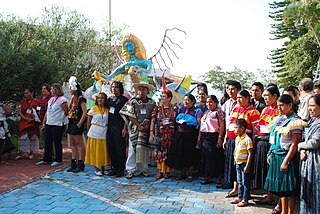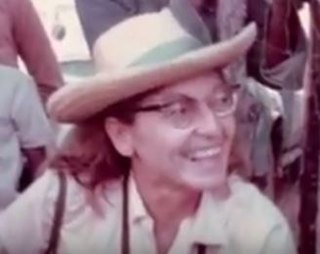
Barro negro pottery is a style of pottery from Oaxaca, Mexico, distinguished by its color, sheen and unique designs. Oaxaca is one of few Mexican states which is characterized by the continuance of its ancestral crafts, which are still used in everyday life. Barro negro is one of several pottery traditions in the state, which also include the glazed green pieces of Santa María Atzompa; however, barro negro is one of the best known and most identified with the state. It is also one of the most popular styles of pottery in Mexico. The origins of this pottery style extends as far back as the Monte Albán period. For almost all of this pottery's history, it had been available only in a grayish matte finish. In the 1950s, a potter named Doña Rosa devised a way to put a black metallic-like sheen onto the pottery by polishing it before firing. This look has increased the style's popularity. From the 1980s to the present, an artisan named Carlomagno Pedro Martínez has promoted items made this way with barro negro sculptures which have been exhibited in a number of countries.

The Franz Mayer Museum, in Mexico City opened in 1986 to house, display and maintain Latin America’s largest collection of decorative arts. The collection was amassed by stockbroker and financial professional Franz Mayer, who collected fine artworks, books, furniture, ceramics, textiles and many other types of decorative items over fifty years of his life. A large portion comes from Europe and Asia but most comes from Mexico itself with items dating from the 15th to the 20th centuries. Many pieces in the collection are fine handcrafts, such as textiles and Talavera pottery, and they are important because they are items that often did not survive because most did not consider them worth preserving.

Mexican handcrafts and folk art is a complex collection of items made with various materials and intended for utilitarian, decorative or other purposes. Some of the items produced by hand in this country include ceramics, wall hangings, vases, furniture, textiles and much more. In Mexico, both crafts created for utilitarian purposes and folk art are collectively known as “artesanía” as both have a similar history and both are a valued part of Mexico's national identity. Mexico's artesanía tradition is a blend of indigenous and European techniques and designs. This blending, called “mestizo” was particularly emphasized by Mexico's political, intellectual and artistic elite in the early 20th century after the Mexican Revolution toppled Porfirio Díaz’s French-style and modernization-focused presidency. Today, Mexican artesanía is exported and is one of the reasons why tourists are attracted to the country. However, competition from manufactured products and imitations from countries like China have caused problems for Mexico’s artisans.

The Museo Estatal de Arte Popular de Oaxaca or MEAPO is a small museum in the municipality of San Bartolo Coyotepec just south of the city of Oaxaca in Mexico. It is run by the state of Oaxaca to showcase the entity's handcrafts and folk art tradition, through its permanent collection, online "cyber-museum", collaboration with national and international entities, and sponsorship of events such as craft markets, conferences, and temporary exhibitions. It is dedicated to the crafts and to the artisans and the cultures behind the items. Its collection contains samples of most of the crafts produced in the state, especially the Central Valleys region, but most of its collection consists of barro negro pottery, the specialty of San Bartolo Coyotepec. It is run by director Carlomagno Pedro Martínez, a recognized artisan and artist in barro negro.

Museo Universitario de Artes Populares María Teresa Pomar is a museum dedicated to Mexico's handcrafts and folk art tradition, called “artesanía.” It is part of the University of Colima in the city of Colima, founded by artesanía collector and promoter María Terea Pomar. It contains one of the most important collections of its type in Mexico, covering traditions from around the country as well as the artesanía and traditions of the state of Colima.

Carlomagno Pedro Martínez is a Mexican artist and artisan in “barro negro” ceramics from San Bartolo Coyotepec, in the Mexican state of Oaxaca. He comes from a family of potters in a town noted for the craft. He began molding figures as a child and received artistic training when he was 18. His work has been exhibited in Mexico, the U.S. and Europe and he has been recognized as an artist as well as an artisan. Today, he is also the director of the Museo Estatal de Arte Popular de Oaxaca (MEAPO) in his hometown. In 2014, Martínez was awarded Mexico's National Prize for Arts and Sciences

The Punzo family contains two of the best known copper and silver smiths located in Santa Clara del Cobre, Michoacán, Mexico. The family descends from copper smith Carlos Punzo Córdoba. The two main smiths today are brothers Abdón Punzo Ángel and Ignacio Punzo Ángel, each of whom has his own workshop in which their sons and grandsons work and learn the craft of working copper and silver.
María Teresa Pomar (1919-2010) was a collector, researcher and promoter of Mexican handcrafts and folk art along with the communities associated with them. She began as a collector then working with museums to promote handcrafts and then working to found a number of museums and other organizations to the same purpose. She became one of Mexico’s foremost experts on the subject, serving as director of different organizations and judge at competitions in Mexico and abroad. She died in 2010 while she was serving as the director of the Museo Universitario de Artes Populares of the University of Colima, which changed its name to honor her.
Friends of Oaxacan Folk Art is a non-profit organization dedicated to promoting the traditional handcrafts and folk art of the Mexican state of Oaxaca, especially to encourage young artisans to continue family and regional traditions.

Oaxaca handcrafts and folk art is one of Mexico's important regional traditions of its kind, distinguished by both its overall quality and variety. Producing goods for trade has been an important economic activity in the state, especially in the Central Valleys region since the pre-Hispanic era which the area laid on the trade route between central Mexico and Central America. In the colonial period, the Spanish introduced new raw materials, new techniques and products but the rise of industrially produced products lowered the demand for most handcrafts by the early 20th century. The introduction of highways in the middle part of the century brought tourism to the region and with it a new market for traditional handcrafts. Today, the state boasts the largest number of working artisans in Mexico, producing a wide range of products that continue to grow and evolve to meet changing tastes in the market.

Michoacán handcrafts and folk art is a Mexican regional tradition centered in the state of Michoacán, in central/western Mexico. Its origins traced back to the Purépecha Empire, and later to the efforts to organize and promote trades and crafts by Vasco de Quiroga in what is now the north and northeast of the state. The state has a wide variety of over thirty crafts, with the most important being the working of wood, ceramics, and textiles. A number are more particular to the state, such as the creation of religious images from corn stalk paste, and a type of mosaic made from dyed wheat straw on a waxed board. Though there is support for artisans in the way of contests, fairs, and collective trademarks for certain wares, Michoacán handcrafts lack access to markets, especially those catering to tourists.

Guanajuato handcrafts and folk art are mostly of European origin, although some indigenous work still survives in some communities. The most notable craft is the making of glazed mayolica pottery, followed by handmade traditional toys of various materials, especially a hard paper mache called cartonería. While handcrafts are not a large an industry here as in some other states, it does have several major handcraft markets which sell to tourists and foreign residents. Other handcraft traditions include wrought iron work, tin and glass, wood carving and leather working.

Handcrafts and folk art in Mexico City is a microcosm of handcraft production in most of the rest of country. One reason for this is that the city has attracted migration from other parts of Mexico, bringing these crafts. The most important handcraft in the city is the working of a hard paper mache called cartonería, used to make piñatas and other items related to various annual celebrations. It is also used to make fantastic creatures called alebrijes, which originated here in the 20th century. While there are handcrafts made in the city, the capital is better known for selling and promoting crafts from other parts of the country, both fine, very traditional wares and inexpensive curio types, in outlets from fine shops to street markets.

The Mexican State of Mexico produces various kinds of handcrafted items. While not as well documented as the work of other states, it does produce a number of notable items from the pottery of Metepec, the silverwork of the Mazahua people and various textiles including handwoven serapes and rebozos and knotted rugs. There are seventeen recognized handcraft traditions in the state, and include both those with pre Hispanic origins to those brought over by the Spanish after the Conquest. As the state industrializes and competition from cheaper goods increases, handcraft production has diminished. However, there are a number of efforts by state agencies to promote these traditions both inside and outside of Mexico.

Chiapas handcrafts and folk art is most represented with the making of pottery, textiles and amber products, though other crafts such as those working with wood, leather and stone are also important. The state is one of Mexico's main handcraft producers, with most artisans being indigenous women, who dominate the production of pottery and textiles. The making of handcrafts has become economically and socially important in the state, especially since the 1980s, with the rise of the tourist market and artisans’ cooperatives and other organizations. These items generally cannot compete with commercially made goods, but rather are sold for their cultural value, primarily in San Cristóbal de las Casas.

Hidalgo (state) handcrafts and folk art are mostly made for local consumption rather than for collectors, although there have been efforts to promote this work to a wider market. Most are utilitarian and generally simply decorated, if decorated at all. The most important handcraft traditions are pottery, especially in the municipality of Huejutla and textiles, which can be found in diverse parts of the state. Most artisans are indigenous, with the Otomi populations of the Mezquital Valley being the most dominant. Other important handcrafts include basketry, metal and wood working.

Jalisco handcrafts and folk art are noted among Mexican handcraft traditions. The state is one of the main producers of handcrafts, which are noted for quality. The main handcraft tradition is ceramics, which has produced a number of known ceramicists, including Jorge Wilmot, who introduced high fire work into the state. In addition to ceramics, the state also makes blown glass, textiles, wood furniture including the equipal chair, baskets, metal items, piteado and Huichol art.

Tlaxcala handcrafts and folk art is that which comes from the smallest state in Mexico, located in the center-east of the country. Its best-known wares are the "canes of Apizaco", sawdust carpets and the making of Saltillo-style serapes. However, there are other handcraft traditions, such as the making of pottery, including Talavera type wares, cartoneria, metalworking and stone working. The state supports artisans through the activities of the Fideicomiso Fondo de la Casa de las Artesanía de Tlaxcala

Feria Maestros del Arte is a non profit organization and annual three-day event held to support Mexican handcrafts and folk art in Chapala, Jalisco, Mexico. Unlike other fairs of this type, invited participants are not charged booth fees or percentages, and are even afforded transport and accommodations with area families. The Feria has grown from thirteen artisan participants to over eighty, and the organization is legally recognized in Mexico and the United States.

Ruth D. Lechuga (1920–2004) was an Austrian-born, naturalized Mexican citizen who became a physician and a collector of Mexican folk art. Her interest led her to produce anthropological studies on the cultures of the different states of Mexico. She gave up her medical lab work to work in anthropology, curating several museum collections. Lechuga published research on indigenous Mexican culture and craftwork. Her ethnographic photographs earned her notice as one of the major professionals in the field. Her private collection of 20,000 ethnographic photographs and over 10,000 artifacts were donated upon her death to the magazine Artes de México and the Franz Mayer Museum. Several posthumous showings of the collection have taken place and in 2016, a research center bearing her name was opened in the former basement of the Franz Mayer Museum.


















